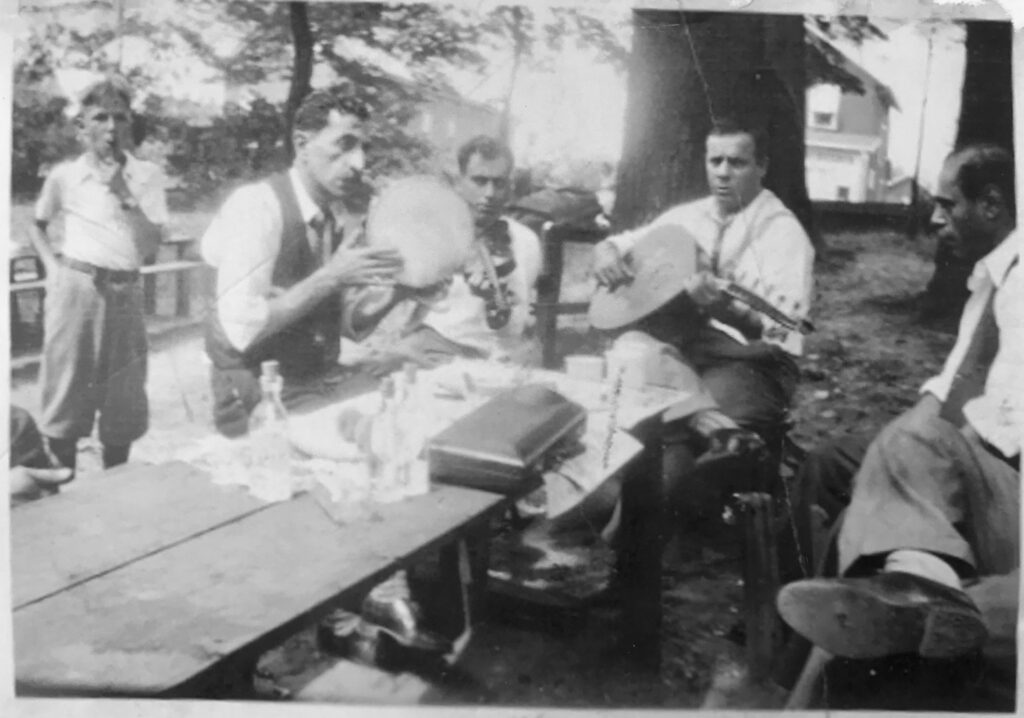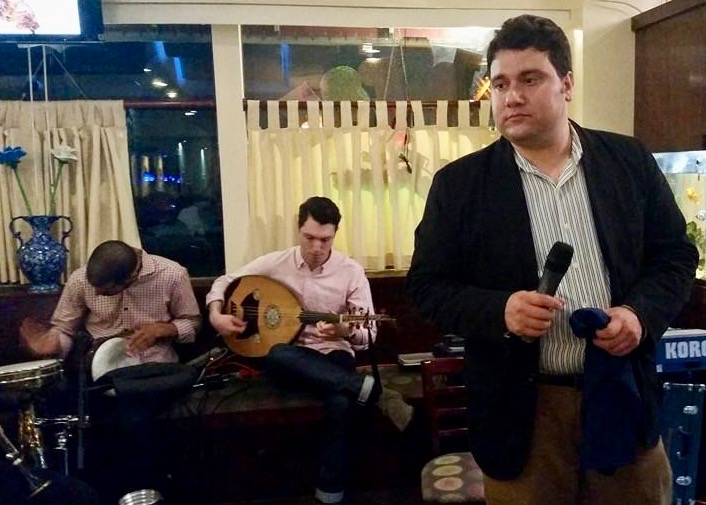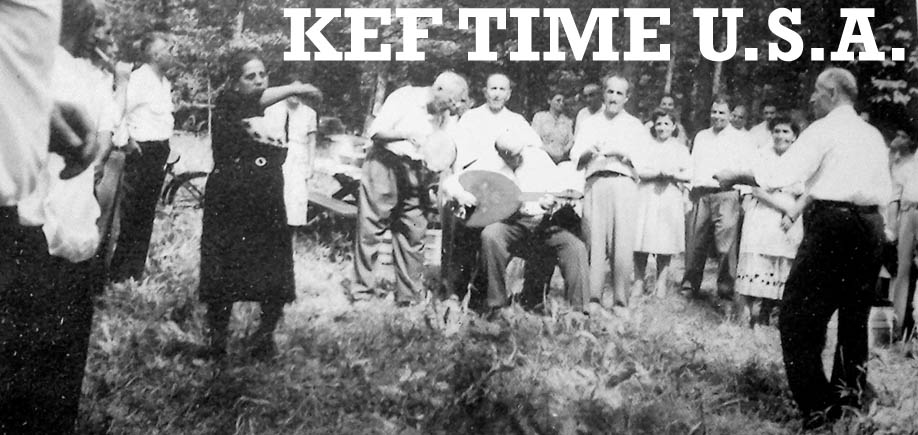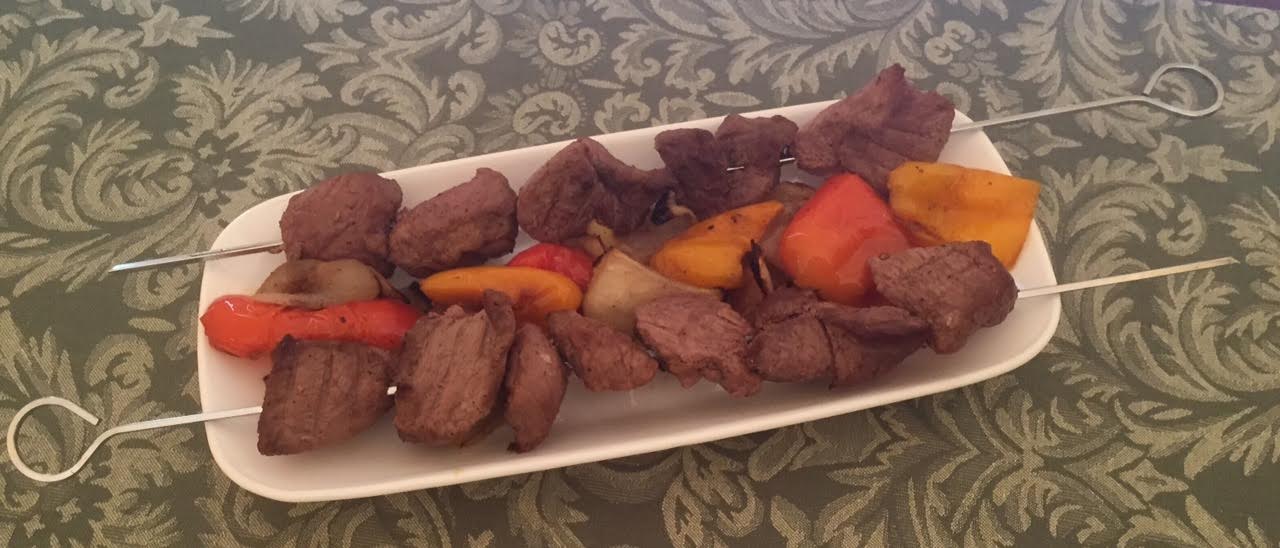Picnics were important to Armenian immigrants early in the last century.
As soon as the weather warmed, they eagerly fled their crowded tenements and boarding houses for fields or parks where they could eat, sing and even dance as they once did in their homeland.
Bringing an oud to these gatherings was as important as bringing food. The Armenians who came to America after the Genocide salvaged little except the songs they remembered from happier times. Many were simple folk tunes with lyrics that served as snapshots of a world they’d never see again.
A pretty girl with auburn hair. Apples ripening on a tree. A fluttering crane.
Survivors sang these songs, plucked their ouds and thumped dumbegs while kebab sizzled on a grill. A drink or two soon had everyone not only singing but dancing in a line, linked pinkie-to-pinkie. They called such impromptu parties “making kef.”
You might consider it a form of self-administered music therapy.

The more they made kef, the livelier and louder the music became. By the time I was growing up in the 1950s, Armenians were still making kef but the party had spread to nightclubs and social halls across the country.
Since then, new waves of Armenians have arrived from Lebanon, Syria and even Armenia itself, each marching to its own beat. I’ve learned to enjoy this evolving music but it left me feeling wistful about the old traditions that nurtured the sounds and rhythms I grew up with.
My view brightened, however, after I spoke to Harry A. Kezelian III. He convinced me “kef music” is alive and thriving.
“I’m passionate about music,” Harry says. “But I’m especially passionate about kef music. It’s an art form that comes from the heart. It’s an important part of our culture.”
His ardor is noteworthy because he’s no nostalgic Boomer like me. At 35, with degrees in law and teaching, Harry devotes himself to writing about music for the Armenian Mirror-Spectator newspaper. He also created a Kef Time U.S.A. blog that traces the origin of Armenian popular songs and celebrates the musicians such as Hovsep Shamlian and Karekin Proodian who continued to compose and popularize Armenian music after they came to America.
Nothing captures the kef spirit better than the photo at the top of Harry’s blog showing Surpouhi and Hagop Manoogian, both born in Yerzinga, dancing to music played by their compatriots at a Detroit-area picnic in 1934.
Harry’s affinity for this music developed from his devotion to other aspects of Armenian culture, which became more pronounced as he got older. He grew up in Detroit’s vibrant Armenian community but didn’t speak Armenian until he studied it in college. As a youth, his musical taste leaned to blues and jazz.
“I heard Armenian music but I didn’t really listen to it,” he said. Then one day he found a stack of phonograph records in the attic, including the 1968 album “Kef Time Las Vegas.”

“It just blew me away, ” he said. “What these guys were doing was unbelievable. Richard Hagopian’s oud intricacies were on another level.”
Harry had been playing clarinet since the fifth grade. It is not a traditional Armenian instrument but it became one in the hands of American-born musicians, notably Detroit’s own Hachig Kazarian. “When I heard his Armenia, Armenia CD—wow. I took out my clarinet and started to teach myself those songs by ear.”
He later taught himself to play the oud and also sings with his own band, the Kef Tones. Now he is working on a book about kef music in America. “It’s not from a technical perspective,” he says. “I want to document the history of the scene, the bands, the people.”

The early masters have long passed, but Harry has gotten to know and interview many of the musicians such as Onnik Dinkjian and the late Mike Vosbikian who inherited the kef tradition from those pioneers and helped it evolve into the music Harry and his friends danced to at church picnics and summer camp.
With such a wealth of knowledge and enthusiasm, Harry was an obvious choice when we looked around for someone to explain what kef music is and why people love it.
Here’s what he had to say.
Kef Music
By Harry A. Kezelian
What is kef music? My parents and grandparents simply called it Armenian music. If you asked them to qualify that, they might say it’s “the kind of music we play at Armenian weddings and picnics.”
There was no need to elaborate.
For many years, the popular music of the American-Armenian community was essentially the popular music of the Armenians of Anatolia, present day Turkey. As the community in America developed, this was the music played at picnics, dances, weddings and house parties.
Today, many Armenians play other styles of music at such events, especially the pop and continental music favored by Armenians from Lebanon and Armenia itself. The term kef music emerged in America in the 1990s to distinguish bands that played the old-style music from newer groups that were giving them competition.
The term is actually somewhat controversial, and can even be a bit confusing.
Kef, which can mean fun or party, is a Turkish word commonly used by Diaspora Armenians whose families came from the Ottoman Empire. It is also used in the Republic of Armenia, which was long under Russian rule. But if you ask a person in Armenia to play kef music, you’ll hear something entirely different from what we are talking about.
Not all kef music is even party music. Some of the most evocative solos are for listening.
The term kef music was popularized by events such as “Kef Time Hartford” and the “Cape Cod July 4th Kef Weekend,” which took place annually and featured only this style of music. Both events had started as a way to bring oudist-singer Richard Hagopian from Fresno to New England with his all-star “Kef Time Band.”
Similar events in the Northeast took off, and this old-style music grew in popularity with a new generation. It took such a hold on its audience that an early Internet list of “10 ways to tell you are Armenian” included the line: “You get an adrenaline rush at the mention of the word kef.”
The true origins of kef music spanned from Ottoman Art Music of Constantinople to Armenian folk music from remote mountainous villages, and everything in between. It was native Armenian and it was also Middle Eastern. It was not classical in the European sense, and it was not Armenian church music.
It was based on a system of modes, which are similar to scales. It was played in small bands of three to five people using instruments such as the oud, violin, clarinet, kanoon (Middle Eastern lap harp), dumbeg (hand drum), tambourine and saz (long-necked Anatolian lute).
Eastern Armenian music was generally not classified as kef music. Kef music is Anatolian through and through, though in later years there were some influences from the Caucuses. Kef music always uses acoustical instruments, although the sound is usually amplified.
If you are playing a solo on a synthesizer keyboard with a drum machine, or if you are playing melodies meant for ballroom dancing, you aren’t playing kef music. A major part of the artistry of kef music is improvisation. There is little or no harmony, although starting in the late ‘50s guitar players were introduced into the kef bands who played something like a rhythmic bass line. Most of these guitarists in the early days were of Greek origin, as the Greeks had decades of experience adapting rhythm guitar style to Eastern Mediterranean type melodies.
Instead of harmony, there are melodies that can range from complex to repetitive. One part of the improvisatory nature comes from simply playing the melody. Although the melodic instruments such as oud and clarinet are playing the same melody they aren’t really in unison. They add runs, trills, and ornamentation, which means each instrument is playing the melody slightly differently.
The clarinet may take the lead while the oud plays more to the off-beat, or in a kind of countermelody. Even the drummer adds fills and effects to make his drumming more exciting. The instruments do not clash but complement each other. Aficionados will recognize this improvisation from New Orleans style jazz, though the melodies of Armenian songs are usually in a minor key.
The second and more exciting aspect of improvisation is what is known as take offs or rides. Similar to swing-era jazz, a kef band will generally play the song relatively straight as the vocalist goes through several verses of lyrics. When the vocalist is done the melody instruments like the clarinet or oud will “take off” and improvise solos.
They are like the jazz solos from artists such as Louis Armstrong and others, playing in the middle of a dance tune.
Instruments often take turns doing solos, just as jazz or bluegrass musicians do. Some might protest at the comparison and note that rock bands also take guitar solos, but a rock guitarist is expected to play his solo the way he did it on a recording. The kef musician is expected to improvise and express his heart and soul in the heat of the moment.
The lyrics of kef songs may be in Armenian or Turkish. The repertoire comes from songs Armenians learned during the Ottoman Era, and many of the Turkish songs were written by Armenians. In the 50s, orchestrated folk records from Soviet Armenia satisfied the longing of the immigrants to hear their mother tongue, especially in folk melodies, and those songs also entered the “kef” repertoire.
City nightclubs in Istanbul and Izmir dominated by Armenian, Greek, and Jewish musicians and often associated with belly dancing, gave birth to many Turkish “kef songs” which were later translated into Greek and popularized in Greece as the genre of “Smyrneiko.” Anatolian rural wedding musicians who were usually Armenians and sometimes Assyrians contributed the Armenian folk repertoire, which combined with the Istanbul nightclub music gave birth in the United States to what we now know as kef music.
Folk dances from all regions of historic Armenia such as Van, Erzurum and Kharpert were preserved in the United States because the music accompanying these traditional dances were in the repertoire of the kef bands.
Dances like the Tamzara, Haleh (Kochari), Pampouri, Sepastia-Bar, and others are still part of the way Armenian-Americans celebrate today. Armenians continued dancing their traditional line dances, as well as the solo dancing known as “tak bar” to the Armenians.
Armenian men at a picnic would sip their “rakhi” (similar to ouzo) and shout the lyrics to the songs, as the oud player plucked along. The women would get up and dance delicately in solo style. The men would get up and dance, arms around each other’s shoulders, stamping their feet. The whole community would link pinkies and dance in a huge chain.
A young man might grab his sweetheart and pull her to the center of the circle, where they would execute a duet “solo” dance. This music was played at the most important times in one’s life – weddings, and communal festivities like picnics or dinner-dances at the conventions of different community organizations.
This music reminded the older generation of their homeland. It tied the newer generation to the memory of that homeland and its culture, and to their Armenian identity.
The language of the lyrics didn’t matter to the early immigrants. This was the music they knew and loved. And when the oud player played a taksim—unaccompanied instrumental improvisation, sometimes used as an introduction to a song—people felt the weight of history, their ancestors, the sorrow of life and the world, and what it means to be an Armenian and to be a human.
When the dance music would start again—those strange dance melodies that could be as sad as the blues and as sprightly as bluegrass—the people would be back to having fun, but they knew just how important and precious the freedom to have fun is.





Wonderful info! Thanks for posting
It’s our pleasure; so happy you like it!